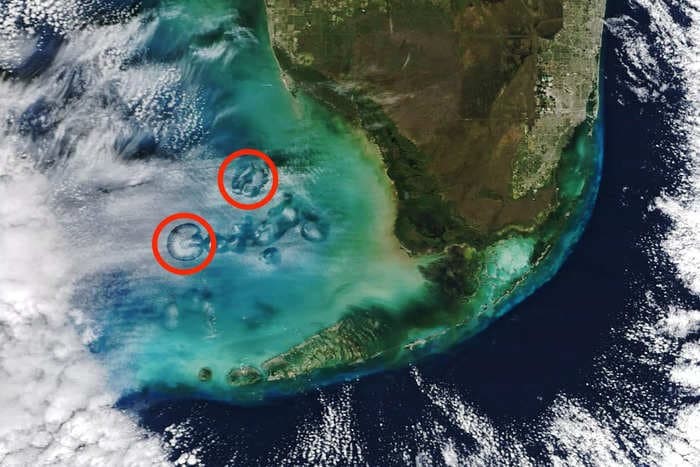Description

Disclaimer: Copyright infringement not intended.
Context
NASA satellite captures ‘odd holes’ in clouds caused by aeroplanes.
Details
Cavum clouds
- These clouds appear as if a large circle or ellipse has been neatly cut from the clouds, leaving feathery wisps in the middle of the hole, often referred to as hole-punch or fallstreak holes.
- These atmospheric phenomena, characterized by large, circular openings in the clouds, with delicate, feathery trails within, have sparked imaginations and fueled speculation about their origins, including theories of UFOs and extraterrestrial activity.
Cloud holes: The cavum cloud phenomenon
- An impressive example of cavum clouds was observed over the Gulf of Mexico near Florida’s west coast on January 30, 2024.
- Captured by the Moderate Resolution Imaging Spectroradiometer (MODIS) aboard NASA’s Terra satellite, this image provides a stunning view from above, showcasing the natural beauty and complexity of these cloud formations.
- The intrigue surrounding cavum clouds has been a topic of scientific discourse since the 1940s, with various hypotheses proposed over the decades. However, it wasn’t until a comprehensive study conducted by scientists.
Science behind the spectacle
- These cloud formations are caused by aircraft, dispelling more fantastical theories.
- Altocumulus clouds are mid-level clouds consisting of supercooled liquid water droplets. Supercooling occurs when water droplets remain liquid even at temperatures below water’s typical freezing point, due to their purity and absence of particles like dust or pollen that would normally initiate ice formation.
- This phenomenon is relatively common in the Earth’s atmosphere, particularly within altocumulus clouds, which cover approximately 8% of the Earth’s surface at any given time and are mostly composed of droplets supercooled to around -15°C.

How airplanes influence cloud formations
- The formation of cavum clouds is initiated when airplanes disrupt these delicate atmospheric conditions. As aircraft move through these clouds, the air around their wings and propellers undergoes adiabatic expansion, cooling the water droplets further, sometimes by more than 20°C.
- This cooling can prompt the supercooled droplets to freeze, starting a chain reaction where ice crystals form and grow, eventually becoming heavy enough to fall.
- This process leaves behind a void in the cloud layer, with the falling ice crystals creating the wispy trails known as virga visible in the center of the cavum.
Environmental factors that cause cloud holes
- The study found that the shape and size of the cavum depend on the angle at which planes intersect the cloud layer — sharp angles produce small, circular cavum, while shallow angles result in elongated “canal clouds” adorned with virga trails.
- Factors such as the cloud layer’s thickness, air temperature, and the degree of horizontal wind shear also play roles in creating these cloud holes.
- The researchers’ analysis indicated that aircraft of various types, from large passenger jets to turboprops, are capable of creating cavum and canal clouds.
MODIS
- NASA’s Moderate Resolution Imaging Spectroradiometer, or MODIS, stands as a pivotal instrument in the realm of Earth observation. Mounted aboard two of NASA’s satellites, Terra and Aqua, MODIS provides an unparalleled vantage point for monitoring our planet’s atmosphere, oceans, and land.
- Since its first launch in 1999 on Terra and subsequently on Aqua in 2002, MODIS has been capturing the Earth’s dynamic beauty and the subtle interplays within its ecosystems, offering invaluable data to scientists and researchers around the globe.

Science behind MODIS
- MODIS operates with a precision that allows it to capture data in 36 spectral bands, ranging from visible to thermal infrared wavelengths. This wide spectrum enables the detection of various indicators, such as chlorophyll levels in oceans, atmospheric water vapor, and land cover changes.
- By providing comprehensive coverage of the Earth’s surface every one to two days, MODIS plays a crucial role in tracking environmental changes over time, aiding in the understanding of global dynamics and environmental processes.
Contributions to science and humanity
- The impact of MODIS extends far beyond mere observation. Its data has been instrumental in enhancing our understanding of climate change, detecting and monitoring wildfires, assessing the health of agricultural lands, and tracking the spread of harmful algal blooms.
- Furthermore, MODIS’s ability to observe phytoplankton in the ocean contributes to our understanding of the oceanic carbon cycle, crucial for assessing the health of marine ecosystems.
|
PRACTICE QUESTION
What is a defining characteristic of Cavum Clouds?
- They are formed exclusively in low-altitude cloud layers.
- They are often accompanied by thunderstorms.
- They exhibit a cylindrical hole surrounded by wispy edges.
- They are primarily composed of ice crystals.
Answer C
|
















